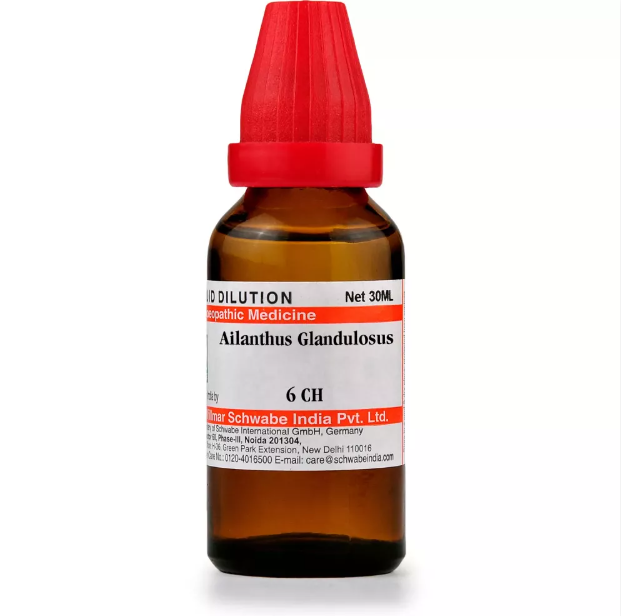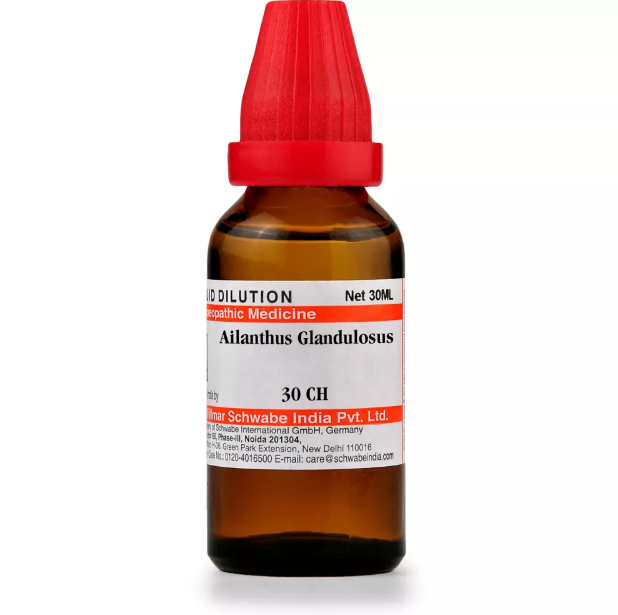AILANTHUS GLANDULOSA Q, 6C, 12C, 30C, 200C, 1M, 10M USES AND SYMPTOMS
 AILANTHUS GLANDULOSA
AILANTHUS GLANDULOSA
(Chinese Sumach)
Ail.
This unique remedy reveals its potent ability to disrupt the bloodstream through distinctive skin symptoms, manifesting in low-grade fevers, eruptive diseases, diphtheria, follicular tonsillitis, streptococcal infections, gangrene, hemorrhagic diathesis, and more. The skin takes on a livid or purplish hue, while the face adopts a dark mahogany tone, radiating heat. Other indicators include sordes, swollen and purple throat, semi-consciousness, delirium (meningitis), weak pulse, general torpor, and profound prostration. Strikingly akin to malignant scarlatina, symptoms encompass diarrhea, dysentery, and deep prostration, all marked by adynamia. Lividity, stupor, and a sense of malignancy pervade its conditions. Mucous membranes may become hemorrhagic and ulcerative (similar to Lachesis and Arsenicum).
Mind: Overall stupor coupled with a sighing, confused mind. Mental depression.
Head: Frontal headache accompanied by drowsiness. Characterized by passive, congestive headaches.
Eyes: Suffused, dilated eyes with photophobia.
Nose: Thin, copious, ichorous, and bloody nasal discharge.
Face: Dusky complexion.
Mouth: Dry and brown tongue. Teeth covered with sordes.
Throat: Inflamed, edematous, dusky red throat with marked internal and external swelling. Dry, rough, choking sensation, with tenderness and swelling in the neck. Hoarse, croupy voice. Pain during swallowing extending to the ears (dysphagia).
Respiratory: Rapid and irregular breathing. Dry, hacking cough. Sore and tired lungs.
Sleep: Drowsy, restless. Heavy, disturbed, and unrefreshing.
Skin: Annual recurrence of miliary, livid rashes. Large blisters filled with dark serum. Irregular, patchy, livid eruptions that disappear under pressure. Cold to the touch. Associated with Raynaud’s disease.
Relationship: Antidotes: Rhus-tox, Nux-v.
Comparison: Am-c., Bapt., Arn., Mur-ac., Lach., Rhus-t.
Dosage: First to the sixth potency.
SYMPTOMS OF AILANTHUS GLANDULOSA
 Skin Symptoms:
Skin Symptoms:- Livid or purplish hue.
- Dark mahogany tone on the face, radiating heat.
- Sordes on the skin.
- Swollen, purple, livid throat.
- Semi-consciousness, delirium (meningitis).
- Weak pulse, general torpor, and profound prostration.
- Symptoms similar to malignant scarlatina.
- Diarrhea, dysentery, and profound prostration with adynamia.
- Lividity, stupor, and a sense of malignancy.
- Mucous membranes may become hemorrhagic and ulcerative (similar to Lachesis and Arsenicum).
Mind:
- General stupor with a sighing, confused mind.
- Mental depression.
Head:
- Frontal headache with drowsiness.
- Passive, congestive headaches.
Eyes:
- Suffused, dilated eyes.
- Photophobia.
Nose:
- Thin, copious, ichorous, bloody nasal discharge.
Face:
- Dusky complexion.
Mouth:
- Dry and brown tongue.
- Teeth covered with sordes.
Throat:
- Inflamed, edematous, dusky red throat.
- Marked internal and external swelling.
- Dry, rough, choking feeling.
- Tenderness and swelling in the neck.
- Hoarse, croupy voice.
- Pain during swallowing, extending to the ears (dysphagia).
Respiratory:
- Hurried and irregular breathing.
- Dry, hacking cough.
- Sore and tired lungs.
Sleep:
- Drowsy, restless.
- Heavy, disturbed, unrefreshing sleep.
Skin:
- Annual recurrence of miliary, livid rashes.
- Large blisters filled with dark serum.
- Irregular, patchy, livid eruptions disappearing under pressure.
- Cold to the touch.
- Associated with Raynaud’s disease.
selection of the potency
Individualization:
- Homeopathy is based on the principle of treating the individual, not just the disease. The unique symptoms and characteristics of the person are crucial in determining the most suitable potency.
Intensity of Symptoms:
- The intensity of the symptoms guides the choice of potency. If the symptoms are intense and acute, a lower potency (e.g., 6C, 30C) might be considered. For chronic conditions with less intensity, higher potencies (e.g., 200C, 1M) may be appropriate.
Sensitivity of the Patient:
- Some individuals are more sensitive to homeopathic remedies, while others may require higher potencies. The practitioner considers the patient’s sensitivity when selecting the potency.
Acute vs. Chronic Conditions:
- Lower potencies are often used for acute conditions, while higher potencies may be considered for chronic or long-standing issues.
Previous Response to Potencies:
- The patient’s response to previous homeopathic treatments helps guide the choice of potency. If a particular potency has been effective in the past, it may be repeated or adjusted as needed.
Vital Force and Susceptibility:
- Homeopathy views illness as a disturbance in the vital force. The practitioner assesses the patient’s overall vitality and susceptibility to determine the appropriate potency.
Aggravation or Amelioration:
- The direction of the symptom response (aggravation or amelioration) after taking a remedy can influence the choice of potency.
Miasmatic Considerations:
- In classical homeopathy, the concept of miasms (inherited disease tendencies) is considered. The practitioner take this into account when selecting the potency.
Practitioner Experience:
- The experience and preference of the homeopathic practitioner play a role. Some practitioners may have success with certain potencies based on their clinical experience.
SAFETY INFORMATION
- Do not exceed the recommended dose by physician
- Keep out of the reach of children
- Store in a cool dry place away from direct sunlight
- Maintain half an hour gap between food/drink/any other medicines and homoeopathic medicine
- Avoid any strong smell in the mouth while taking medicine e.g. camphor, garlic, onion, coffee, hing
Medicine images use for reference only selection of homeopathic medicine depends on the individual’s specific symptoms and overall constitution. Moreover, homeopathy is a holistic system of medicine that treats the individual as a whole. In addition to addressing the physical symptoms, it takes into account the emotional and mental state of the person. Consequently, it’s crucial to consult with a qualified homeopathic practitioner for personalized treatment.
The information provided on this website is intended solely for educational purposes. Always seek the advice of your physician or other qualified health provider.
